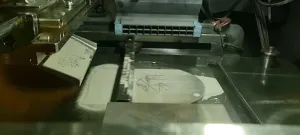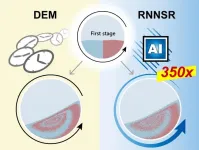(Press-News.org) Researchers have developed a new method for 3D printing metal that could help reduce costs and make more efficient use of resources.
The method, developed by a research team led by the University of Cambridge, allows structural modifications to be ‘programmed’ into metal alloys during 3D printing, fine-tuning their properties without the ‘heating and beating’ process that’s been in use for thousands of years.
The new 3D printing method combines the best qualities of both worlds: the complex shapes that 3D printing makes possible, and the ability to engineer the structure and properties of metals that traditional methods allow. The results are reported in the journal Nature Communications.
3D printing has several advantages over other manufacturing methods. For example, it’s far easier to produce intricate shapes using 3D printing, and it uses far less material than traditional metal manufacturing methods, making it a more efficient process. However, it also has significant drawbacks.
“There’s a lot of promise around 3D printing, but it’s still not in wide use in industry, mostly because of high production costs,” said Dr Matteo Seita from Cambridge’s Department of Engineering, who led the research. “One of the main drivers of these costs is the amount of tweaking that materials need after production.”
Since the Bronze Age, metal parts have been made through a process of heating and beating. This approach, where the material is hardened with a hammer and softened by fire, allows the maker to form the metal into the desired shape and at the same time impart physical properties such as flexibility or strength.
“The reason why heating and beating is so effective is because it changes the internal structure of the material, allowing control over its properties,” said Seita. “That’s why it’s still in use after thousands of years.”
One of the major downsides of current 3D printing techniques is an inability to control the internal structure in the same way, which is why so much post-production alteration is required. “We’re trying to come up with ways to restore some of that structural engineering capability without the need for heating and beating, which would in turn help reduce costs,” said Seita. “If you can control the properties you want in metals, you can leverage the greener aspects of 3D printing.”
Working with colleagues in Singapore, Switzerland, Finland and Australia, Seita developed a new ‘recipe’ for 3D printed metal that allows a high degree of control over the internal structure of the material as it is being melted by a laser.
By controlling the way that the material solidifies after melting, and the amount of heat that is generated during the process, the researchers can programme the properties of the end material. Normally, metals are designed to be strong and tough, so that they are safe to use in structural applications. 3D printed metals are inherently strong, but also brittle.
The strategy the researchers developed gives full control over both strength and toughness, by triggering a controlled reconfiguration of the microstructure when the 3D printed metal part is placed in a furnace at relatively low temperature. Their method uses conventional laser-based 3D printing technologies, but with a small tweak to the process.
“We found that the laser can be used as a ‘microscopic hammer’ to harden the metal during 3D printing,” said Seita. “However, melting the metal a second time with the same laser relaxes the metal’s structure, allowing the structural reconfiguration to take place when the part is placed in the furnace.”
Their 3D printed steel, which was designed theoretically and validated experimentally, was made with alternating regions of strong and tough material, making its performance comparable to steel that’s been made through heating and beating.
“We think this method could help reduce the costs of metal 3D printing, which could in turn improve the sustainability of the metal manufacturing industry,” said Seita. “In the near future, we also hope to be able to bypass the low temperature treatment in the furnace, further reducing the number of steps required before using 3D printed parts in engineering applications.”
The team included researchers from Nanyang Technical University, the Agency for Science, Technology and Research (A*STAR), the Paul Scherrer Institute, VTT Technical Research Centre of Finland, and the Australian Nuclear Science & Technology Organisation. Matteo Seita is a Fellow of St John’s College, Cambridge.
END
Using lasers to ‘heat and beat’ 3D-printed steel could help reduce costs
2023-10-30
ELSE PRESS RELEASES FROM THIS DATE:
Positive messages can mitigate harm from objectified fitness posts
2023-10-30
PULLMAN, Wash. – A few words of body appreciation can help counter the negative impact of viewing objectified images of female fitness influencers, according to a Washington State University study.
While fitness influencers say they want to inspire good physical health, research has found that their social media posts often inspire negative mental health, especially among younger women. The WSU experimental study, published in the journal Health Communication, revealed that the negative impact ...
Extreme heat projected to increase cardiovascular deaths
2023-10-30
For immediate release on Oct. 30, 2023 at 5 a.m. ET
Cardiovascular-related deaths due to extreme heat are expected to increase between 2036 and 2065 in the United States, according to a study supported by the National Institutes of Health. The researchers, whose work is published in Circulation, predict that adults ages 65 and older and Black adults will likely be disproportionately affected.
While extreme heat currently accounts for less than 1% of cardiovascular-related deaths, the modeling analysis predicted this will change because of a projected rise in summer ...
Heat-related cardiovascular deaths in the U.S. may more than double within decades
2023-10-30
Research Highlights:
Cardiovascular deaths from extreme heat in the United States are projected to increase by 162% by the middle of the century, based on a hypothetical scenario where currently proposed U.S. policies to reduce greenhouse gas emissions have been successfully implemented.
A more dire scenario forecasts cardiovascular deaths from extreme heat could increase by 233% in the next 13-47 years if there are only minimal efforts to reduce emissions.
The percentage increase in deaths ...
Penn research projects increase in US cardiovascular deaths due to extreme heat
2023-10-30
PHILADELPHIA— The number of heat related cardiovascular deaths in the United States will increase over the next four decades, according to a new analysis from the Perelman School of Medicine at the University of Pennsylvania. Extreme heat can impact heart health in many ways, including increased heart rate, changes in blood pressure, and increased inflammation. Left untreated, these issues can be deadly. The findings, published today in Circulation, also indicate that older adults and Black adults will experience greater increases in excess cardiovascular deaths due to extreme heat.
“As global temperatures rise, analyzing how demographic and environmental trends ...
Child Development Perspectives Journal Q&A: analyzing the stereotypes of adolescence
2023-10-30
In Western cultures, adolescence is often viewed as a time of rebellion and irresponsibility. A new article published in the journal Child Development Perspectives synthesized recent research on stereotypes of adolescence using an interdisciplinary approach which integrates developmental psychology, cultural psychology, and neuroscience.
The findings highlight the importance of avoiding the “one-size fits-all” assumptions about teen stereotypes across different cultures. In particular, the research ...
Trauma-informed training workshops prompt meaningful individual and organizational changes, according to outcomes surveys
2023-10-30
A McLean Hospital study of 598 people across various industries who underwent a two-day training workshop where they learned about trauma-informed care and how to deploy these skills within their organizations, found participants reported significant gains in knowledge of trauma and made improvements to organizational policies, according to a comparison of survey data collected before and after the trainings.
Among those trained, who included nurses, CEOs, academics and corrections officers, post-survey scores increased ...
Study of 1,000 selfies helps explain how we use them to communicate
2023-10-30
People have used self-portraits to communicate information about themselves for centuries — and digital cameras make it easier to share a self-portrait than ever before. But even though selfies are now almost ubiquitous, we don’t understand how people use them to communicate. So scientists from the University of Bamberg set out to investigate the semantics of selfies.
“Although the term ‘selfies’ is now celebrating its 21st birthday, and although selfies are known in art history for nearly 200 years in photography and more than 500 years in paintings, we still lack a clear classification of the different types of selfies,” ...
Powder engineering adds AI to the mix
2023-10-30
Imagine a world without powders. It may sound exaggerated, but our daily lives are intricately connected to powders in various ways from foods, pharmaceuticals, cosmetics to batteries, ceramics, etc. In all these industries, powder mixing is an important unit operation where different types of powders are mixed to achieve uniformity. However, it can be difficult to predict what conditions are optimal to achieve the desired uniformity as the process often relies on trial and error as well as engineers’ expertise.
Numerical ...
Risk of admission and death from COVID-19 low overall, but oldest adults remain vulnerable
2023-10-30
About 80% of residents in the Lower Mainland, British Columbia, had been infected with SARS-CoV-2 by July 2023 and were at low risk for severe outcomes, but almost half of the oldest adults remained uninfected and were at highest risk of hospitalization and death due to COVID-19, according to a new study published in CMAJ (Canadian Medical Association Journal) https://www.cmaj.ca/lookup/doi/10.1503/cmaj.230721.
The findings underscore the need to continue prioritizing older adults for COVID-19 vaccination.
"First-ever SARS-CoV-2 infections among older adults may still contribute substantial COVID-19 burden, reinforcing ...
High engagement, high return: The secret to student success
2023-10-29
High engagement, high return. That’s the advice from education experts at the University of South Australia for teachers looking to improve student outcomes.
In a new study conducted in partnership with Flinders University and Melbourne Graduate School of Education, researchers found that less than a third of teachers are engaging students in complex learning, limiting student opportunities for building critical thinking and problem solving.
Filming and assessing* the content of classrooms ...





